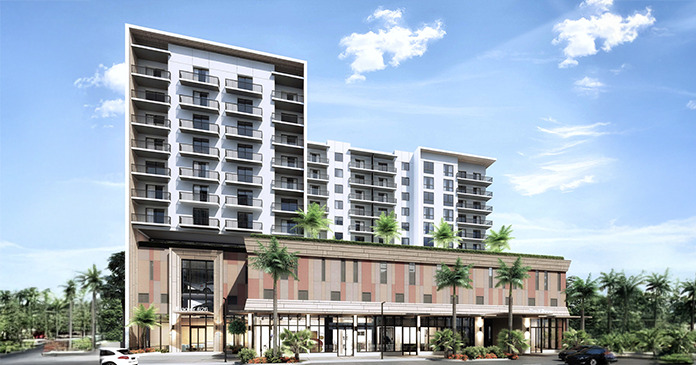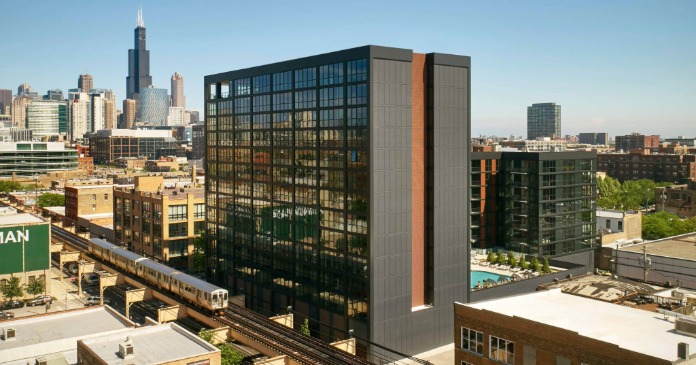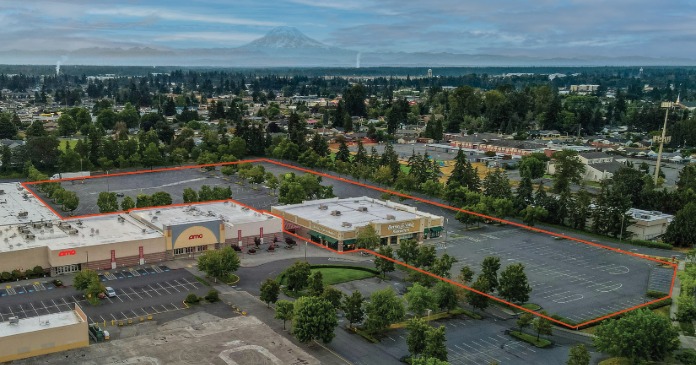Apartment fundamentals are improving, beginning in the leading coastal markets and moving inward to laggard markets like Denver, Charlotte, Atlanta, St. Louis and Chicago.
The rental sector received a power boost from diminished supply thanks to the immense wave of condo conversion activity that swept the nation over the past few years, the limited number of apartments built during the same period and increasing job growth.
“The premium to own versus rent is at a 20-year high because of the huge run-ups in single-family home and condo prices.” says Ron Terwilliger, Chairman and CEO of Atlanta-based Trammell Crow Residential (TCR) since 1986.
Price appreciation and recent interest rate hikes are making it tough for first-time home buyers to make the leap from renter to homeowner. Demographics also favor rental as the echo boomers, more than 83 million young adults born between 1977 and 1997, enter the market choosing to rent.
Also good news for apartment players is the fact that no more market-rate rental housing exists now than five years ago. “Much that’s been built has been affordable, and rent levels are about the same as they were in 2001,” says Terwilliger. “Yet renters today are paying less as a percentage of their income for rent. That means if the economy stays the course, there will be more room to raise rents.”
TCR was strictly a market-rate rental housing developer until 2000, when the company moved into affordable rentals and the condo business. By 2005, TCR’s projects were pretty much divided equally between for-sale and market-rate rental, with a small portion affordable. But Terwilliger’s crystal ball was crystal clear last year when he predicted the condo trend would run out of steam in 2006.
“The single-family housing market has slowed. Pent-up demand has been filled and people are exhausted from the frenetic activity,” says Terwilliger. “Today, we’re being selective on our condo plans and have expectations that it will return to business as usual. Speculators have left the market.”
TCR’s development pipeline is heavily weighted on the market-rate apartment side. Terwilliger anticipates starting 10,000 units by year-end — 3,000 condos, mostly in Downtown San Diego, and 7,000 rentals, 1,000 of which will be affordable. He wants to ramp up development to 12,000 units in 2007.
“We’re active in Texas, Phoenix, Denver, and the Carolinas. We have nothing now in the Mid-Atlantic, but we’re pursuing land in the Northeast and we control a number of sites. And, we like the Pacific Northwest and California, both north and south,” says Terwilliger, who finds it almost impossible to pencil any market-rate rental project in the Golden State today.
As a developer, there are several hurdles to overcome, especially if you’re not a REIT with a huge revolving line of credit. Just as landowners still expect to sell at condo prices, investors seem to be demanding higher yields, according to Prudential Real Estate Investors’ Q2 2006 market perspective report. This especially is true in secondary markets where rent growth looks less promising.
The yield factor
Terwilliger’s biggest challenge is getting investors to accept lower yields, which are running between 5% and 6.5% on development, based on today’s rents. TCR is aggressively trending rents out four years in its rental model underwriting and convincing its partners that rent growth will remain strong over that period. Trending rents is a strategy used by apartment REITs like Archstone-Smith, BRE Properties and Essex Property Trust.
“I’m emphasizing rental and convincing our partners to finance as much development as they can, recognizing the project could be condo six or seven years down the road, when the next cycle gets strong,” says Terwilliger. Before that happens, he notes, interest rates have to come down.
One of TCR’s development partners is Boston Capital, a fully integrated finance company, based in Boston, Mass., and one of the largest owner/investors in multifamily housing in America. Boston Capital recently formed a joint venture with TCR to build the 228-unit Alexan MetroPointe in the Phoenix suburb of Tempe.
Mark W. Dunne, senior VP and director of market rate housing for Boston Capital, sees trending rents as a function of the market. “Some markets demand higher yields,” explains Dunne. “But in markets with real job growth, we’re comfortable trending on lower yields. There are very few places better than Greater Phoenix for job growth — 105,000 jobs were added last year and another huge number is expected this year. Supply is relatively moderate and condo conversion activity has put favorable pressure on rents.”
Jeff Allen, managing director of TCR Southwest, believes the old rule of thumb of a 200 basis point spread has been marginalized by market conditions. However, he expects to meet or exceed those expectations on Alexan MetroPointe. “We expect yields in the low 7% range, trending rents at a conservative rate. The project is in a high-growth sub-market in a land-locked city close to a large and growing employment hub.”
Alexan MetroPointe, a garden-style asset with one-, two- and three-bedroom units, will break ground in December on a 19-acre brownfield site in Maricopa County, five miles southeast of downtown Phoenix. First units are expected to deliver in October 2007 with completion scheduled in May 2008. Rents are underwritten at $1.07. The architect is Todd & Associates.
Boston Capital and TCR also are partnering on the 240-unit Alexan Pembroke Woods in Pembroke, Mass., an area considered part of Greater Boston’s south market.
The cost factor
“Most investors have accepted lower going-in cap rates and are still interested in multifamily, although there is a point where some transactions don’t make sense. Our partners understand that value creation will be there down the road,” says Alliance Residential CFO Jay Heimenz.
Heimenz believes improving NOI will offset cap rates that may increase with rising interest rates. He is more concerned with nimbyism and rising costs that make projects riskier and harder to pencil than he is with convincing investors to accept lower yields.
Another challenge Heimenz sees is the ever more complicated entitlement process for apartments. “In a lot of markets, there aren’t many sites available for rental. We have to manufacture them,” says Heimenz. “We buy both entitled and un-entitled sites, but we’re having to do more of the latter, although it’s a smaller part of our business plan.”
Alliance Residential has been accelerating its property line and expanding its footprint since 2000, opening several new offices each year. Last year, the company more than doubled development starts to 3,700 units from 1,800 units in 2004, and will continue to accelerate apartment development and acquisitions this year and next.
“We’re concerned, as is everyone, with the volatility in construction costs caused by materials demand from outside the border and all the home building over the past years,” says Heimenz.
“Litigation, worker and construction liability all make development more costly. Land and municipal fees have gone up by multiples and are three times what they were in the past, making some rental projects not feasible in markets where fundamentals haven’t fully developed.”
“Some developers in those markets turned to for-sale product. We didn’t enter that game. Now we’re seeing cooling off on demand for for-sale product. That’s good news, as are the high occupancies and rental rate growth of 5-plus percent in some of our markets that help to mitigate the cost increases. We’re seeing much less turnover for home purchase and strong demand relative to supply.”
Alliance Residential targets high-barrier or high-growth metros in Northern and Southern California, Seattle, Phoenix, Albuquerque, Denver, Las Vegas, the Texas markets and, most recently, Atlanta. Heimenz wants to extend development from Jacksonville up to the Mid-Atlantic and is on a wait-and-see in Southeast Florida. “We are looking at an apartment project in Tampa — condo converters are out of that market — and we’re looking to pick up projects converters are walking away from,” he said.
Alliance Residential plans to start 4,500 units this year with an investment of $700 million and plans to spend $250 million to acquire an additional 3,000 units. Next year, the company’s budget ramps up to $1 billion — $800 million armarked for development and the rest for acquisitions. Development projects will be split between high-density — concrete podium and mid-rise projects in markets like urban Denver, California and some in Dallas — and stick-built gardens-style communities.
The company is doing limited for-sale development, all in California, which is less cyclical than other markets. One such project is the proposed Broadstone Hollywood — 130 condos above a 99-seat ground-floor theatre that will take the place of an existing 200,000 s.f. office building.
Alliance Residential and Prudential Real Estate Investors, its equity partner on the deal, paid $29 million for the property last November. Construction should start in February with completion in 2008. “California is the only market where we can justify building condos, and where we will continue to do both land sales and for-sale on a selective basis. We really are till rental guys,” says Heimenz.
The condo factor
Bill Donges joined Lane Company as COO four years ago, when the apartment industry was at a low point and Lane was an Atlanta-centric company. In 2002, he oversaw the company’s move into the growing condo market as president of CondoLane and was instrumental in unifying Lane’s previously independent investment, construction, development, property management and condo companies under the Lane Company banner. In spring 2005, he took over the CEO position from George Lane, who remains chairman and owner.
“The big news for Lane,” says Donges, “is that we’ve decentralized our developments more in the line of a Trammell Crow Residential and a Wood Partners.” Lane today is focusing on markets from Connecticut down to Florida and across to Texas with a pipeline of 3,906 units at a cost basis of $629.96 million for 2007.
Donges’ biggest challenge is finding and retaining talent. “It’s a big issue, and it’s not going to go away next year or the year after,” he says. “There are certain levels of people that are extremely difficult to find in both construction and development, and even — management — people who have seven to 10 years experience and have done deals and have been project managers and are ready to move up to the next level. You have to hire them at a price you can afford, but also bring them into the system that properly aligns them.”
Donges knows first-hand that difficulty. Lane Company recently increased the number of its development directors from one to eight and is in the process of opening new offices in Dallas, Raleigh/Charlotte, Washington D.C./Northern Virginia, Orlando and a Gulf Coast office that will handle business in Mississippi, Alabama and Louisiana.
The 30-year-old company historically focused between 10% and 20% of its activities on condos and between 80% and 90% on apartments until 2000, when the condo market was just beginning to gather steam. For the past five years, Lane’s focus has been 80% condos and 20% rental. “I think the condo wave has passed and we’re moving into a new era, or maybe just a traditional swing,” says Donges. “Banks are financing condos very differently, requiring higher pre-sales and tighter target dates to achieve those sales. In the past six months, we’ve clearly seen that in the tea leaves and our projects now are 80% apartments and 20% condos again, with few exceptions unless there’s a differentiating location or a unique story,” says Donges.
He tells one of those unique stories about 100 condo units Lane plans to build on 3.5 acres of run-down waterfront in the quaint city of Fernandina Beach on Florida’s Amelia Island, a resort getaway for Atlantans. The condos will be part of a mixed-use development with 9,500 s.f. of water-facing retail and a 100-slip marina with the ability to accommodate luxury yachts. When it breaks ground next summer, Lane’s project will kick off the area’s redevelopment.
“In certain spots like Fernandina Beach, condos still work very well,” says Donges. However, in Tampa, he decided apartments are the way to go on another 3.5-acre site the company recently bought in the West Kennedy sub-market. Lane originally planned the project as 220 condos. But so many apartments in the area have been converted to condos that Lane is re-tooling its plans, hoping to add more density, if that can be accomplished within the municipality’s open space requirements.
“Lane is considered a horizontal builder, not a vertical builder. We don’t build high-rise and, consequently, we can make those shifts — not painlessly, but relatively easily. There are some problems with the valuations of the land and how you do that, but clearly if you were building a high-rise you could never do that. You’d just have to go forward and take what the market bears.”
The Gulf Coast project will feature an urban design with an updated amenity package built in the Texas-wrap style with parking in the center. Units will average 930 s.f. and rent for an average of $1,555. Lane won’t start building until January, after the company razes some office buildings on the property.
Other Florida markets that are seeing condos revert to rental are Fort Lauderdale, Orlando and Miami. “What’s going to happen with the excess supply of condos is going to be interesting,” says Donges. “I don’t know how to predict that in some areas.”
















